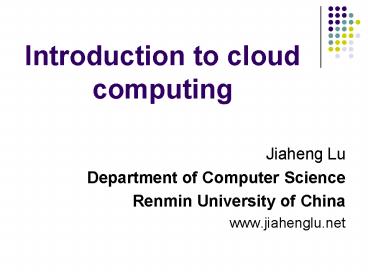Introduction to cloud computing - PowerPoint PPT Presentation
1 / 44
Title:
Introduction to cloud computing
Description:
Jiaheng Lu Department of Computer Science Renmin University of China www.jiahenglu.net Why we use cloud computing? Why we use cloud computing? Case 1: Write a file ... – PowerPoint PPT presentation
Number of Views:1146
Avg rating:3.0/5.0
Title: Introduction to cloud computing
1
Introduction to cloud computing
- Jiaheng Lu
- Department of Computer Science
- Renmin University of China
- www.jiahenglu.net
2
Course purpose
- Teach in English
- Introduce students some basic knowledge about
cloud computing
2
3
Course contents
- Basic knowledge
- Google , Yahoo! , Amazon cloud technology
- Hadoop Mapreduce Practice
3
4
Lecturer Academic experience
- 2006.9 2008.6 University of California, Irvine,
Postdoc researcher - 2002.8 2006.8 National University of Singapore,
PhD candidate - 1998.9 2001.1 Shanghai Jiao Tong University
Master candidate
5
University of California, Irvine
6
Research in Postdoc
Data integration in medical system US patent
Approximate string search ICDE08
6
6
7
National University of Singapore
7
8
Course grading
- Hadoop code writing (Java) 40
- In-class presence and quiz 30
- Final presentation 30
8
9
Teaching assistant
- Cheng ming
- Any problem about Hadoop java codes, you may
email him.
9
10
Any question and any comments ?
11
Cloud computing
12
(No Transcript)
13
Why we use cloud computing?
14
Why we use cloud computing?
- Case 1
- Write a file
- Save
- Computer down, file is lost
- Files are always stored in cloud, never lost
15
Why we use cloud computing?
- Case 2
- Use IE --- download, install, use
- Use QQ --- download, install, use
- Use C --- download, install, use
- Get the serve from the cloud
16
What is cloud and cloud computing?
- Cloud
- Demand resources or services over Internet
- scale and reliability of a data center.
17
What is cloud and cloud computing?
- Cloud computing is a style of computing in
which dynamically scalable and often virtualized
resources are provided as a serve over the
Internet. - Users need not have knowledge of, expertise in,
or control over the technology infrastructure in
the "cloud" that supports them.
18
The architecture of cloud computing system
19
What is cloud computing
- Video
- http//v.youku.com/v_show/id_XMTYxODA1MjE2.html
20
Characteristics of cloud computing
- Virtual.
- software, databases, Web servers,
operating systems, storage and networking as
virtual servers. - On demand.
- add and subtract processors, memory, network
bandwidth, storage.
21
Types of cloud service
SaaS Software as a Service
PaaS Platform as a Service
IaaS Infrastructure as a Service
22
SaaS
- Software delivery model
- No hardware or software to manage
- Service delivered through a browser
- Customers use the service on demand
- Instant Scalability
23
SaaS
- Examples
- Your current CRM package is not managing the load
or you simply dont want to host it in-house. Use
a SaaS provider such as Salesforce.com - Your email is hosted on an exchange server in
your office and it is very slow. Outsource this
using Hosted Exchange.
24
PaaS
- Platform delivery model
- Platforms are built upon Infrastructure, which is
expensive - Estimating demand is not a science!
- Platform management is not fun!
25
PaaS
- Examples
- You need to host a large file (5Mb) on your
website and make it available for 35,000 users
for only two months duration. Use Cloud Front
from Amazon. - You want to start storage services on your
network for a large number of files and you do
not have the storage capacityuse Amazon S3.
26
IaaS
- Computer infrastructure delivery model
- A platform virtualization environment
- Computing resources, such as storing and
processing capacity. - Virtualization taken a step further
27
IaaS
- Examples
- You want to run a batch job but you dont have
the infrastructure necessary to run it in a
timely manner. Use Amazon EC2. - You want to host a website, but only for a few
days. Use Flexiscale.
28
Cloud computing and other computing techniques
29
30
Grid Computing Cloud Computing
- share a lot commonality
- intention, architecture and technology
- Difference
- programming model, business model, compute
model, applications, and Virtualization.
31
Grid Computing Cloud Computing
- the problems are mostly the same
- manage large facilities
- define methods by which consumers discover,
request and use resources provided by the central
facilities - implement the often highly parallel computations
that execute on those resources.
32
Grid Computing Cloud Computing
- Virtualization
- Grid
- do not rely on virtualization as much as Clouds
do, each individual organization maintain full
control of their resources - Cloud
- an indispensable ingredient for almost every Cloud
33
(No Transcript)
34
Any question and any comments ?
2013-11-14
34
35
Distributed system
36
A distributed system
B
A
C
D
37
client-server system
Client
Client
Client
Server
Client
38
multiple servers
Server
Server
Server
Server
Server
39
Applications
- Amazon
- Airline reservation systems
- Finance e-transactions, e-banking,
stock-exchange - Military
40
Why distributed systems?
What are the advantages?
distributed vs centralized? multi-server vs
client-server?
41
Why distributed systems?
What are the advantages?
distributed vs centralized? multi-server vs
client-server?
- Geography
- Concurrency gt Speed
- High-availability (if failures occur).
42
Why not distributed systems?
What are the disadvantages?
distributed vs centralized? multi-server vs
client-server?
43
Why not distributed systems?
What are the disadvantages?
distributed vs centralized? multi-server vs
client-server?
- Expensive (to have redundancy)
- Concurrency gt Interleaving gt Bugs
- Failures lead to incorrectness.
44
References
- http//www.cloudcomputing-china.cn/
- http//dotnetslackers.com/articles/sql/Introductio
n-to-Cloud-Computing.aspx - http//www.hudong.com/wiki/E4BA91E5AE89E58
5A8 - http//en.wikipedia.org/wiki/Cloud_computing
45
QA Thanks































